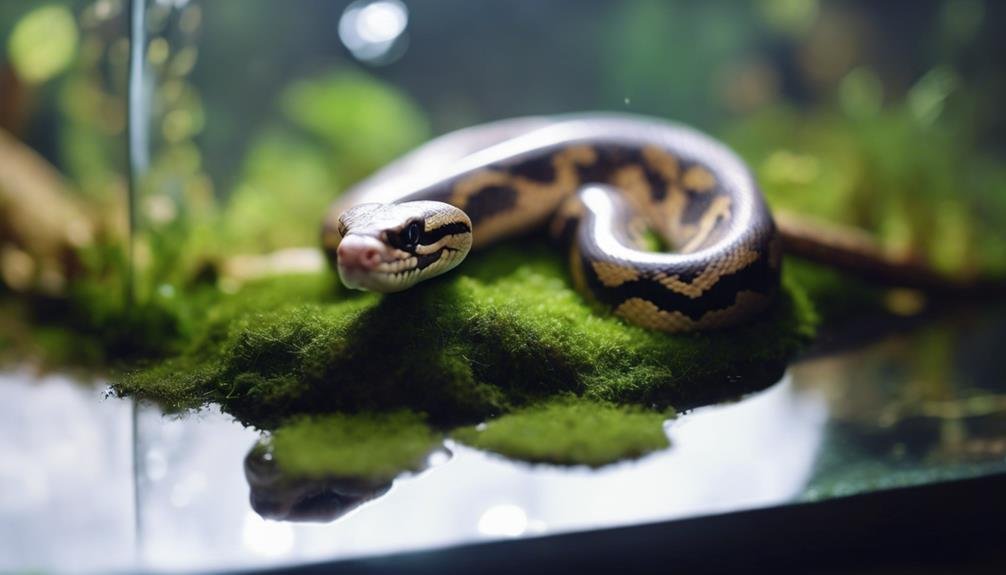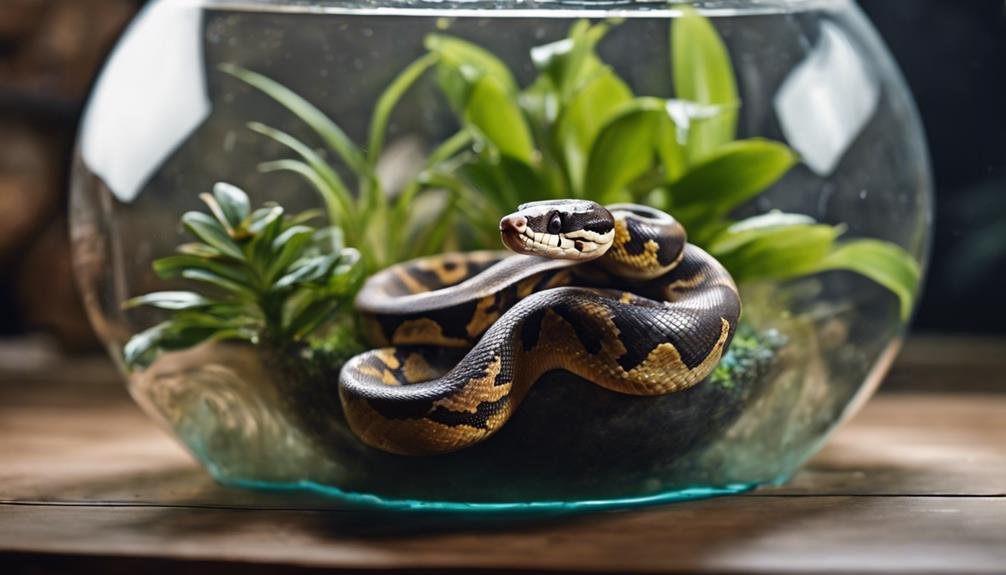You might be curious about how your ball python interacts with water, especially when it comes to swimming, bathing, and shedding. It's important to understand that while they don't naturally seek out large bodies of water to swim in, they do exhibit a preference for soaking, particularly when shedding. This behavior helps soften their skin and guarantees a smoother shedding process. However, the balance between providing enough water for soaking and avoiding the risks associated with swimming is delicate. Let's explore the nuances of how water plays a vital role in their care, without diving too deeply into myths that surround their aquatic behavior.
Key Takeaways
- Ball pythons may soak in their water bowls to aid the shedding process and hydrate.
- They do not naturally swim and can be at risk of respiratory issues if submerged.
- Before shedding, they often show increased interest in water to soften their skin.
- Maintaining correct humidity levels in their enclosure is crucial for their health and shedding.
- Providing a separate, shallow bathing area with warm water can safely meet their hydration and shedding needs.
Understanding Ball Python Behavior
To understand ball python behavior, it's important to observe their interactions with water, as their soaking habits can vary widely from one individual to another. You might find your ball python basking in its water bowl, a behavior often seen before the shedding process begins. This bathing isn't just an important activity; it serves a practical purpose, especially for hydration. Every ball python has its unique preferences, with some indulging in water soaks more frequently than others. While you might worry if your scaly friend spends a lot of time submerged, remember, regular soaking might just be their way of expressing a fondness for water. However, if it's an occasional dive, it's generally not a red flag.
But, there's a twist. If you spot your ball python soaking more often than usual, it's wise to play detective. Before you write it off as a simple preference, check for signs of mites or issues with stuck shed, as these conditions can prompt unusual soaking behavior. Maintaining proper habitat temperatures is also key in ensuring your ball python isn't soaking in an attempt to regulate its body temperature.
The Role of Water in Shedding
Understanding your ball python's affinity for water becomes especially important as they approach the shedding phase, where hydration plays a key role in facilitating the process. Water is not just a medium for your snake to drink; it's a crucial component in guaranteeing a smooth shedding cycle. Adequate hydration leads to softening skin, making it easier for your ball python to shed its old skin in one piece.
| Aspect of Shedding | Role of Water |
|---|---|
| Softening Skin | Water helps to hydrate your ball python's skin, making it more pliable and easier to shed. |
| Shedding Assistance | Soaking in water can loosen any pieces of stuck shed, aiding in a complete shedding process. |
| Hydration Benefits | Proper hydration, both internally and in the habitat's humidity, supports overall health and facilitates easier shedding. |
| Humidity Levels | Maintaining the correct humidity level in the enclosure ensures the environment is conducive to shedding. |
You'll likely notice your ball python showing more interest in water as they prepare to shed. This natural behavior underscores the importance of providing access to water for soaking, alongside managing the humidity levels in their environment, to guarantee a successful and stress-free shedding cycle.
Swimming: Myths Vs. Reality


Did you know that despite popular myths, ball pythons actually aren't swimmers and can face serious risks if submerged in deep water? It's a common misconception that these snakes have aquatic instincts pushing them towards swimming. In reality, their water preferences lean more towards staying hydrated rather than taking a dip. Unlike some reptiles that thrive in aquatic environments, ball pythons don't exhibit the same behavior in the wild or captivity, making swimming an unnatural and often stressful activity for them.
Submerging them in water can't only stress them out but also lead to respiratory issues, a serious concern for their well-being. Hence, it's important to stick to safety measures that cater to their natural needs without exposing them to unnecessary risks. A shallow water dish for drinking satisfies their hydration needs perfectly without encouraging or allowing them to swim. Remember, while it might seem like a fun idea to watch your ball python glide through water, it's not in their best interest. Steering clear of such activities ensures they remain healthy and stress-free.
Creating a Humidity-Controlled Environment
Creating a humidity-controlled environment is essential for the health and comfort of your ball python, requiring careful monitoring to maintain humidity levels between 50-60%. During shedding periods, it's vital to increase humidity to 65% or higher to aid in the shedding process. Here's how you can guarantee ideal humidity for your snake:
- Use a Digital Hygrometer: This tool is indispensable for accurate monitoring and adjustment of humidity levels within your python's enclosure. It helps you keep a close eye on the environment, making sure it stays within the ideal range.
- Incorporate Water Bowls: Placing large water bowls in the enclosure can help increase humidity levels. The larger the surface area of the water, the more moisture will evaporate into the air, assisting in humidity regulation.
- Install Mist Systems: For a more automated solution, consider using mist systems. These systems can be programmed to release a fine mist into the enclosure at set intervals, boosting humidity levels and mimicking the natural habitat of your ball python.
How Does a Ball Python’s Age, Weight, and Size Affect Their Relationship with Water and Shedding?
The age, weight, and size of a ball python can significantly affect their relationship with water and shedding. Younger and smaller snakes may struggle to regulate humidity levels, leading to difficulties in shedding. It’s important to provide an appropriately sized water dish and maintain proper humidity levels to support healthy shedding for ball pythons of any age, weight, and size.
Bathing Alternatives for Ball Pythons


When considering how to bathe your ball python, opting for a separate storage bin with a latching lid offers a practical alternative. Fill this bin with 88-degree water to a depth that lets your python soak comfortably, ensuring they can fully enjoy the soaking benefits without the drawbacks of a less controlled environment. It's important to correct humidity levels inside this bin during soaking sessions. Normally, maintaining 55-60% humidity is essential for your python's health, but this should be increased to 65% or more during shedding periods to support the process.
Proper handling techniques are essential when transferring your python in and out of the bath. Make sure you're gentle, supporting their body to reduce stress. As for bathing frequency recommendations, it's not necessary to soak your ball python too often—only as needed for hydration or to aid with shedding. Always use a digital hygrometer to accurately measure the humidity inside the bin, ensuring effective soaking sessions. This approach not only provides a safe and comfortable bathing alternative but also helps in maintaining the ideal health of your ball python through precise humidity management.
Conclusion
To sum up, while ball pythons aren't natural swimmers, they do enjoy a good soak, especially during shedding. It's essential to keep their environment humid and offer large water bowls to aid in this process.
Remember, swimming can be risky, so stick to providing baths with proper techniques instead. By understanding their needs and offering bathing alternatives, you're helping your python stay hydrated and healthy, ensuring a smooth shedding process.
Keep their well-being in mind, and they'll thrive under your care.


